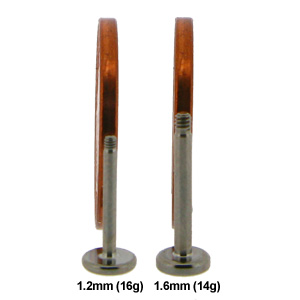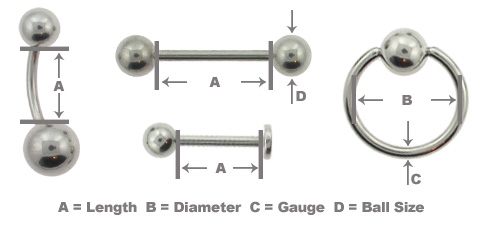Measuring your own body piercing jewellery
We get asked all of the time questions like:
- “What size tongue bar do I need?”
- “What length belly bar do I need?”
- “I want to change my labret stud but don’t know what size I need to buy”
Unfortunately a lot of piercing shops do not explain to their customers about the different sizes that body jewellery comes in when they are pierced (I know that there are some great piercers out there that explain everything to, its just that we tend to hear more about the ones that don’t).
Well basically piercing jewelry usually has 2 measurements:
1 – Thickness or Gauge
You will see 2 measurements refered to regarding thickness – mm (milimeters) which tends to be used in the UK and Europe, and Gauge (g) which is used more commonly in the US.
To give you some idea in the UK a 1 penny coin is approximately 1.6mm (14g) thick

- Labret studs are availble with a thickness of 1mm (18g), 1.2mm (16g) or 1.6mm (14g)
- Eyebrow Bars are usually 1.2mm (16g)
- Nose Studs can be either 0.8mm (20g) or 1mm (18g)
- Ear Piercings vary depending on the piercing itself and can be between 0.8mm (20g) to 1.6mm (14g), obviously for people with stretched ear lobes this measurement is larger.
- Nipple piercings are usually 1.6mm (14g)
- Tongue Piercings are usually 1.6mm (14g)
- Belly bars are usually 1.6mm (14g)
Obviously we can only say “usually” because the size of jewellery used in a piercing may vary depending on the person, the piercer and how long ago it was pierced. For example tops of ears years ago were pierced with standard ear piercing guns, so the jewellery was quite thin, sometimes only 0.8mm (20g), but now that piercing should be done with a needle and will more commonly be 1mm (18g) or 1.2mm (16g).
While belly bars or rings are usually 1.6mm (14G) we get people call that have thinner 1.2mm (16g) bars, and some people actually stretch their tounge piercings, so they will require a thicker bar.
2 – Length or Diameter
- Labret studs can be anything in length from 5mm (4g) through to 18mm (1/2″), they can be used in lots of different piercings such as ear piercings, madonna piercings, pierced lips and tongues…
- Eyebrow bars and rings will vary in size – the “average” size is 8mm (5/16″) but again this can vary and be much smaller or longer
- Nipple Piercings again vary and an “average” size can be 14mm (9/16″) to 16mm (5/8″), but again we have been asked for 8mm (5/16″) and sometimes 22mm
- Tongue piercings average out at 16mm (5/8″) but this varies a lot and again can be anything from 8mm (5/16″) through to 22mm
- Belly bars – the most common size for navel jewellery is 10mm (3/8″) but this can be as small as 6mm (1/4″) up to 16mm (5/8″)
Generally piercers will pierce with jewellery slightly longer to allow for some swelling, once the swelling has gone down and the piercing is healed usually a slightly smaller piece of jewellery is required. Sometimes peoples bodies can actually reject the piercing causing it to migrate and grow out, this is common with eyebrow piercings and occasionally pierced navels. Sometimes the migration will slow down and settle at a smaller size (eg a 6mm (1/4″) belly button) and will never grow out. Wearing good quality Titanium or Bioplast jewellery rather than Steel can help the body to accept piercings and prevent this from happening.
It is very important to choose well fitting body jewelery, too loose and it may catch on clothes and could rip the piercing, too tight and it could cause irritation to the piercing site and may cause an infection.
It is a good idea to measure an item that fits you comfortably, have a look at our measuring guide to see how the measurements are taken:

